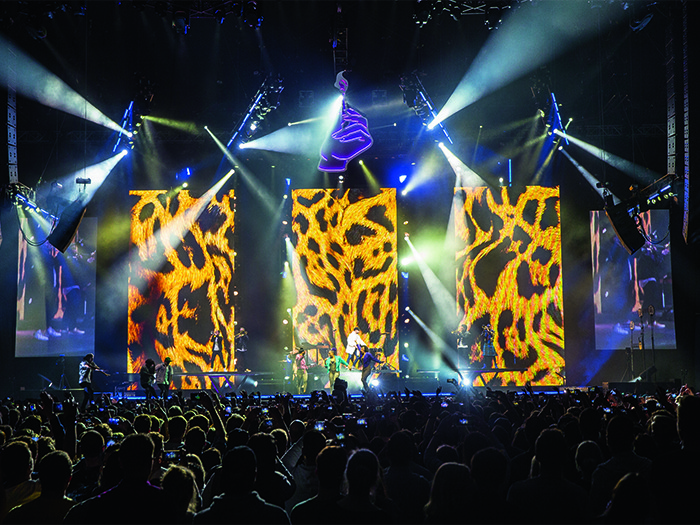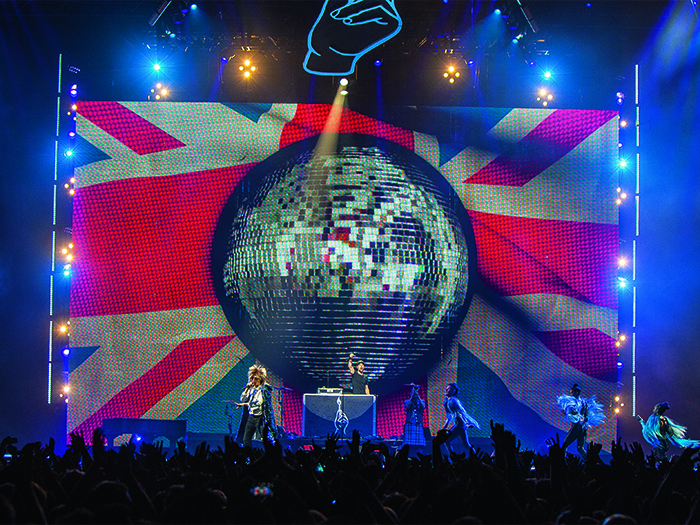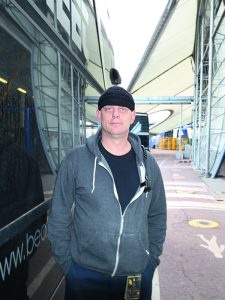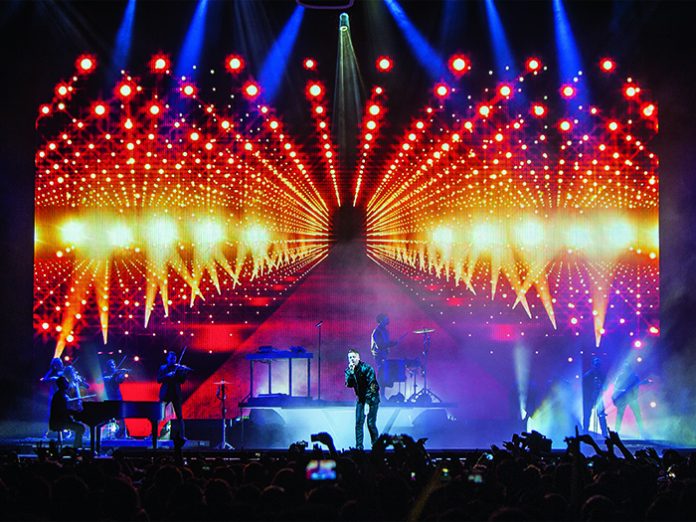US hip-hop duo Macklemore & Ryan Lewis bowled into London’s O2 Arena with a stage show honed during a relentless European tour and crew morale sky high. TPi’s Ste Durham was on site to meet the team.
Even the most experienced of touring crews could be forgiven for feeling the strain after a long stint on the road, particularly when the majority of that crew is thousands of miles from home. In the case of the group behind Macklemore & Ryan Lewis’ latest production, a strong ethos centred around one hand washing the other has done the power of good for on-site unity.
This philosophy stems from Production Manager Chris Fussell, who has spent years carefully assembling a team to realise his utopian idea of life on the tour. He said: “We’ve got a good team here. A lot of these guys have toured with me before and I dictate that everyone helps everyone. It’s the way I like to do things from the first tour meeting. We’re all one big team and everybody’s going to have bad days and good days with load-in or tech issues at one point or another. If there’s no line in the sand as far as duties are concerned then it removes some of that pressure. Everybody got it right away and it removes animosity, which is good for tour morale.”
While talk is cheap, Fussell is very much of the view that leading from the front is the most effective way of instilling his methods within the team. This was never truer than earlier on in Macklemore & Ryan Lewis’ European run. He said: “Everybody has been ill during this tour at one point – our Stage Manager Dave had it worst; we were in the south of France and he had a temperature of 104°, which meant he was in bed for two days, man down. Everybody, including me, jumped in and became the stage manager. If someone finished early then they stayed to help. It wasn’t easy but it was a perfect example of how I like a tour to work. Every tour is different, and there’s no right or wrong way, it’s just how I like to do things. It opens everyone’s eyes to the big picture, and that helps me do my job better as well.”
With his cohesive team in place, Fussell could then focus on the production itself. The concept and design came from Lighting Designer Paul ‘Arlo’ Guthrie, in collaboration with Macklemore (Ben Haggerty) and Ryan Lewis themselves.
Fussell explained: “It started with the stage design and the overall shapes and Arlo applied the lighting and video to cover it equally. Ryan Lewis suggested the idea of video screens that would start upstage, separate into three, move downstage and join back together. During rehearsals and the first few shows we realised that it took too long for them to travel and the system was too cumbersome.”
According to Fussell, almost all of the video content for the tour was collected by Ryan Lewis, a man whose “workaholic” nature serves as the driving force behind the production. He said: “Ryan spends most of the day on tour working, and he and Ben are always together conspiring the best ways to put the show together. They found out what worked and what didn’t after the first night of the tour. With a few further tweaks after the following shows it was pretty much set in stone.”

A number of the vendors present at O2 Arena had been on board since the last Macklemore & Ryan Lewis tour, strengthening relationships Fussell had made while production managing other artists. He explained: “Eighth Day Sound was our audio supplier last time as well, and when Tim Colvard was hired as FOH Engineer he wanted Adamson and d&b audiotechnik PA equipment – Eighth Day stocks both.
“We used PRG in the US for their GroundControl Followspot System, so we used PRG XL Video over here in Europe as well, though they provided the whole system this time. All Access Staging & Productions have done a great job, particularly as we were able to design the stage using stock gear for the most part.”
The crew bedded down at LS-Live’s studios in Production Park, Wakefield, for two and a half weeks in preparation for the European tour. After a two-day load-in, the lighting crew worked day and night in shifts to ensure that the programming was ready for the arrival of the band. The rest of the time was spent working on a selection of new songs in audio rehearsals, before switching to full production rehearsals.
Hip Hop Royalty
We hear a lot of live gigs here at TPi, yet it must be said that the system in place at O2 Arena, masterfully mixed by FOH Engineer Tim Colvard, was particularly impressive.
He said: “This has been my first tour with Adamson. I’d heard prototypes about six years ago, and I just kept my eye on development. Last year I used it on a festival in France for Lionel Richie and from that point I really wanted to try it on an arena tour. This was the perfect application.”
Eighth Day supplied Colvard with 24 Adamson E15 boxes per side for his main hangs, with eight E119 subwoofers flown behind, and a side hang made up of six E119 behind 12 E15’s. The rest of the system consisted of d&b audiotechnik J8 loudspeakers for side fills, a front hang of d&b Y10P’s and 12 Adamson E119’s per side on the ground. This is controlled by his go-to console, the DiGiCo SD7.
Speaking of the Adamson array, Colvard commented: “I love it. It sounds clear, natural, and is very pleasing to the ear. Usually you suffer ear fatigue during a run of back-to-back shows, mainly from overproccesed systems, but this is our 47th of the year and I haven’t felt it at all. I would definitely use it again and again.”
Given his background riding the faders for hip-hop royalty such as Dr Dre, Eminem and 50 Cent, Colvard was well within his comfort zone when TPi came to watch him work in London. To hear Colvard tell it, the formula is tried and tested, and fits perfectly with the sound Macklemore & Ryan Lewis look to achieve.
He continued: “Bass is the foundation of hip-hop but vocal clarity is important. These guys speak so fast sometimes and you need to make sure the audience knows where they are in the song as half the time they are rapping along with the performer. He’s speaking on a lot of political and emotional subjects so you want to make sure that the message gets across.
“Aside from the sound itself you have to know how they are going to perform on stage. For example, most of the time in hip-hop your sub stack also becomes an ego riser and Macklemore is no different. He’ll instinctively run and jump on to them but it’s no problem, you just have to make sure you’re prepared! They came out in the beginning during rehearsals and liked the way it was sounding. So far they’ve trusted management reports and what they feel on stage, it’s a good working relationship.
“The band uses Ableton and there is a DI’d string section, four horns on Shure SM98’s, a couple of guitarists, drums and Ryan Lewis’ DJ setup. We use Sennheiser 5200’s for vocals, which have produced good results for us – keeping the vocals up front and intelligible.”
Colvard used BAE 1073 and Avalon preamps along with older analogue choices such as Eventide H3000 and TC Electronic 2290 delay. “I try to find a good vocal reverb as well. I use a TC Electronic 6000 or Lexicon 960L/LARC2 Software depending on what’s available. It’s just a case of implementing it while the guys are here. Audio-wise it’s been one of the smoothest tours you could ask for.”
Macklemore, Ryan Lewis and the rest of the band are on Ultimate Ears UE 11 Pro in-ears, while the side fills serve as bass reinforcement for the six dancers.
Colvard also reiterated Fussell’s statements about the tour, having nothing but good things to say about the PM and his team: “Chris and I have worked together previously on Beastie Boys and Beck, and it wasn’t a big learning curve for me to come in and figure out what sound the band wanted. In general it’s been upbeat day-to-day and a good tour overall. Usually it’s rare you see everyone pitching in to help but it all comes from Chris and the performers, themselves. If a tour is easy going then it allows you to be as professional as you can be.”
Full Intensity
Lighting Crew Chief, Ryan Tilke was another that joined Macklemore & Ryan Lewis at the beginning of this tour, though he was no stranger to Fussell’s philosophy having forged a relationship during a previous stint with Nine Inch Nails. He said: “In our camp everyone works together – nobody has any problem helping other departments. I have a couple of pyro guys that hang lights for me every day, you get carpenters that run cable out, and we help situate the video where it needs to be. Everyone is on the same page and we try to help each other out.”
PRG XL Video supplied six Robe PATT 2013’s, eight PRG Bad Boy spotlights with accompanying GroundControl Followspot units, eight PRG Best Boys, 64 Chauvet Professional Strike 4’s, 74 GLP Impression X4 Bar 20’s, nine Martin by Harman MAC Rush PAR 2 RGBW Zooms, nine Martin by Haman MAC Viper Air FXs, 20 Ayrton MagicPanels, eight Clay Paky Mythos, 24 Robe BMFLs, 88 Clay Paky Sharpy Wash 330’s, 10 Vari-Lite 4K Beam Washes, 34 Philips Vari-Lite VL5’s, and 14 Vari-lite VL5 Smart Repeaters. The system was controlled by an MA Lighting grandMA2 full size with a grandMA2 light as back up.
The eight PRG Bad Boys were mounted in the truss: four downstage, one right, one left, and two upstage. The eight operators, three lighting crew and five from trucking, were situated behind the stage. Tilke commented: “They’re super intuitive and very easy to use. It’s not a hassle to set up and takes the pressure off one operator. We could let the operators change colour, iris, black out, and so on, but on this tour we have it all pre-programmed in the desk. There’s also four NPUs and PRG Super Nodes to make sure we get the necessary output.”
LD Arlo positioned the Chauvet Strike 4’s throughout his rig to give a tungsten glow and audience abuse where necessary. He explained: “On the US leg of the tour, we have them on downstage truss and on four towers – they are all over. I hung a lot of them in a diamond configuration to create a different look.
“They worked perfectly as a blinder during intense moments. We also strobe them in a few spots, and then we use them as a low level glow wash at a couple of points in the show. I didn’t end up driving them with a media server, but we do some cell chases and patterns with them for some cool looks.
“Of course, we run the Strikes at full intensity for most of the show,” continued Arlo. “The show goes through a lot of messages and moods, but the intensity level is high throughout. There were some more mellow songs, though, where we ran the fixtures on a glow for a super soft wrap.”
The crew split the fibre runs into two sections – the first goes 350ft from FOH to the front truss and joins at dimmer beach behind the video wall, avoiding fire lanes, while an additional cable extends that range by 100ft.
Trans-Atlantic Co-operation
Macklemore & Ryan Lewis have never toured with their own staging elements before, an aspect that Fussell was keen to introduce with a view to elevating the tour to “the next level”.
He explained: “Interacting with audience is a key part of touring in venues this size, and the stage had to look as custom as possible for the minimum cost. We have a history with All Access as we’ve used them for festivals and the guys were great – we made sure to get them on this tour. We brought carpenters from US but we also have some from UK.”
One of the US contingent was Head Carpenter Jesus Arryo, who called the shots when it came to rolling the complex All Access stage. He said: “The whole setup is assembled at one end of the venue, including the three lifts, a toaster, two bunkers stage left and right for monitors and backline and two graded decks downstage for fog and the extra lights to come out.”

During the show the crew were under the stage running the lifts, and preparing instruments, dancers, and props on the decks before they were raised. The toaster lift is operated manually by Arryo and used to allow Macklemore to ‘pop’ out from under the stage once during the intro and twice in later songs to keep the element of surprise.
Arryo continued: “‘Underworld’ is real busy for certain songs as there’s six local hands to help with props and instruments getting on the lifts – there can be up to 12 people underneath at some points in the show. All of the decking for the lifts is custom as is the deck for the toaster and the pointing of the stage, everything else is rental.
“I try to make it as easy as possible for everyone involved. Sometimes time is tight with lighting, screens or rigging, so we always have to be ready to roll. We have to work closely with every department as there’s lighting, video and audio pieces all over the stage. I’ve been touring for 15 years now but this has been awesome. Everybody on the tour is treated like family.”
Road Ready
The video walls were made of 12mm PRG Nocturne V 12 panels, a resolution that Video Crew Chief Johnny Moore felt was ideal for the tour. He explained: “I think for a concert, with all the lighting, bells and whistles, you can get too tight with the pitch. From my experience – the higher the definition, the more delicate the screens. They don’t take as well to bouncing down the road into fast load-ins and outs. You want durability when you are on tour. It doesn’t take a whole lot of that screen to create a 1920 by 1080 pixel field, and personally I think these screens look consistently impressive, even at the downstage edge.”
The automation track, provided by TAIT in the US, that moves the video wall back and forth causes the wall to split into three, meaning, lighting has to be cabled up and over independently using a cable bridge, with everything on sub hung motors.
“Chris was working with the band to see and one of the first concepts was breaking upstage video wall to track downstage then close together at front of stage to be used for reveals and so on. We tried that in rehearsal but it was taking a little to long for them to move the whole way, so they shortened the distance it had to move,” Moore said.
While any video automation can cause problems such as screens knocking together and becoming damaged, Moore felt confident that the screens and the way in which they were rigged would minimise any incidents. He smiled: “TAIT does such a good job with the smoothness of the automation that we don’t have a whole lot of problems. It’s becomes more or less of a given now on so many tours that we know how to handle it. It also helps that we have such a good crew here – Chris has done an incredible job of assembling a team.”
The crew had three manned cameras and three robocams, which were operated by Moore himself. The cameras were paired with one of PRG’s PPUs, based around a Grass Valley Karrera Sport system. Playback content to the screens was driven by PRG Mbox media servers. Moore continued: “The servers get fed through to the PPU to switch between camera feeds and playback content. We also have side screens using double-stacked Barco FLM R22+ projectors, shooting portrait style for IMAG. The PPU system is supplied in Europe by PRG XL Video along with the cameras and projection system.”
Moore concluded: “When the fans comes to a show it’s a multimedia event and there’s so many levels to what’s going on. They expect to be bombarded and the artist has to rise to that level. The days of a few PARcans pointed at someone with an acoustic guitar have all but disappeared. That said – it keeps us working so I’m happy to go with it!”
Party Time
“The band love to make it a party so they use all kinds of special effects,” said Fussell. “The last tour they had cryo, pyro, concussions, flames and so on, so they didn’t want to just mimic that again this year. We added other things like automation and toasters to helps the ebb and flow of the set – though we still had to get some pyro in there!”
Pyrotek’s Nigel Deslippe first came on board with Macklemore & Ryan Lewis to provide pyrotechnic support for a one off show in Seattle, making the decision to stick around based on the evening’s success. He commented: “For this leg of the tour we are using Le Maitre Sparkbursts, Falling Stars, Tracer Comets and Comets with tails for pyro, a pair of Martin by Harman JEM Glaciator X-Streams for the low smoke and eight confetti cannons. We have been running effects this whole tour, both in North America as well as here in Europe. The experience over here has been made so much better with the quality of people put together by this production.
“In terms of health and safety, we have been lucky that the performers know where not to be during the pyro cues. We always have eye on stage left and right to assure everything goes according to plan.”
Production Rigger Joel Gburek took over a supervisory role for the European leg of the tour, though the rig was scaled up considerably from the theatres the duo played in the US. He was also one of the Nine Inch Nails crew, having also worked with Fussell. He remembered: “When we first showed up at LS-Live, the video and automation was heavier. Eventually it was refined and that took more rigging. I handled ‘motor up’, basically ensuring that the right amount of weight is hanging from each part of the building.”
Gburek supervised a different set of local riggers at each show, taking charge of almost 30 at the London date. “They know the building, I know my show. The majority of the rigging gear is Columbus McKinnon, rented from Rig-it – it’s industry standard, roadworthy, tried and true.”
He said that a “good normal rig” consists of an hour to get the gear on the floor, and another three hours for the 70 to 80 motors that need to be installed. As with his PM, Gburek was of the view that the best crewmates to work with are those that see the bigger picture. “At the end of the day we’re all cogs in a machine,” he mused. “The timing is key but that rhythm falls into place during the course of the tour. Everyone is happier when you know what you expect from everyone else. Ultimately we all have the same objective – a smooth load in, a safe rig, the correct engineering, and everything comes down without anyone getting hurt.”

While cohesion with your own team is one thing, Gburek’s duties on the tour also require him to work closely with in-house crews at venues across Europe – even when communicating is not exactly straightforward. He said: “You can go into a house and they can push you towards something that might not be best for the show, but my priority is the show. It’s not a clash, but there are certain times where the ‘usual thing’ has to change to accommodate what the show demands, as long as I’m within the laws of the venue.
“Communication is sometimes an issue in Europe but the bottom line is: if, god forbid, something goes wrong or the locals make a mistake, it’s still my responsibility. That’s the value of research and good planning.”
UK Manager for Mojo Barriers Kevin Thorborn was on site to oversee the install of a full system at O2 Arena. The company supplied 75 metres of barrier along with 20 Vario Corners. Due to the complex shape of the stage, the Vario corners were required to give flexibility when it came to matching its shape and contours, while ensuring the utmost safety.
Thorborn explained: “We dry-hired our barriers, which meant that we didn’t need to supply any crew with the tour. However, we’re always on hand to answer any questions that may arise throughout.
“This is the first time we have worked with Macklemore & Ryan Lewis as well as Chris Fussell, and they have certainly been great with communication and are extremely knowledgeable of our products. The effort that went into the production was huge and this really shines through. It’s been a really great tour.”
Catering giant Eat To The Beat (ETTB) resumed its relationship with Macklemore & Ryan Lewis having provided sustenance on their previous tour in 2013. The team on-site consisted of Richard Huggins, David Lesh, Stephen Wilson, Chloe Whitehead and Rose Ellis, who worked hard to deliver tasty dishes around the clock. ETTB’s Susanne Howell said: “It’s not always easy being the first in and last out, but ETTB are renowned for our delicious home-from-home meals. Not only are we providing meals for the artist and crew, but we are also busy in the background providing all the rider requirements from the main dressing room and making sure the stage coolers are replenished as and when.”
The team made sure that there was something for everyone, whether they had an allergy, were vegan or on a particular diet. Howell continued: “We always had an option or were willing to adapt to make sure everyone had their home comforts while on tour. It’s been a great tour and we would just like to thank everyone and hope to see everyone again soon!”
Fussell chose Stage Truck and Beat The Street to provide trucking and bussing, respectively, for the tour, and was extremely impressed with how both dealt with the complex driving restrictions that are par for the course in European touring. He said: “It’s tough because the drivers have to have their rest periods and logistically it takes a lot of planning. For a tour this size, I feel like I could dedicate one person to doing just that!”
Can’t Hold Us
With the European leg of the tour signed off in style at the O2 Arena, Macklemore & Ryan Lewis headed back home to play run of shows in their native US, before returning for a busy summer festival season.
TPi
Photos: Louise Stickland
www.macklemore.com
www.prg.com/uk/en
www.8thdaysound.com
www.allaccessinc.com
www.taittowers.com
www.ls-live.com
www.globalinfusiongroup.com/gig-eat-to-the-beat
www.stagetruck.com
www.beatthestreet.net
www.mojobarriers.com
www.pyrotekfx.com






